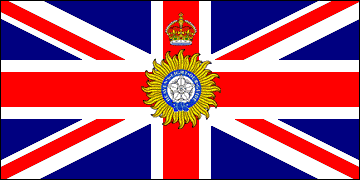|
BRITISH INDIA |
|
In those Indian
territories directly administered by Britain the Union Flag or Union
Jack (UJ) was the proper national flag. For the Viceroy of
India the UJ was charged with the Order of the Star of India under a
royal crown. This flag was permitted to be used at sea for certain
subordinate officials, e.g. governors of British Indian territories.
For merchant vessels registered in British India (as opposed to the
princely states) the proper ensign was the British Red Ensign.
A Red Ensign with the Order of the Star of India in the fly was used to represent British India in international organizations,
leading some sources erroneously to identify it as the national flag
of British India. |
|

The Union Flag |

Civil Ensign |
|

Flag of the Viceroy &
Governor-General of India |

Red Ensign of British
India |
|
THE INDIAN PRINCELY STATES |
|
Most of the
princely states had state flags of which a variety are illustrated
here. Usually the ruling prince had a personal standard; I have
illustrated some of these. Many flags of the princely states are
poorly documented and it is likely that in many cases variants in
different proportions with different color shades, different
arrangements of stripes etc. existed. States with coastlines were
granted British Red Ensigns with a state badge in the fly for use by
merchant vessels. This was done because the state flags were not
internationally recognized and thus could not be used at sea to
indicate nationality as required by international law. I have
illustrated one such ensign. |
|

Hyderabad
State • State Flag
|

Hyderabad
State • Nizam's Flag (?)
|
|
Sources
disagree concerning the state flag of Hyderabad. The flag on the
left, dating probably from the mid-nineteenth century is claimed by
some sources to have been used up to 1948 when the state was
absorbed into India. Others claim that it was replaced at some point
by the flag on the right. That flag, however, bearing the coat of
arms of the Nizam (ruling prince) may have been his personal flag.
Variants with a golden yellow field and red inscriptions are known
to have existed as well. |
|

Gwalior State
• State Flag
|

Gwalior State
• Maharaja's Flag
|
|
The flags of many Hindu-majority states featured
saffron, a color associated with Hinduism. A similar flag was used by the Baroda State. |
|
|

Jammu
& Kashmir •
State Flag
|

Jammu
& Kashmir •
Maharaja's Flag
|
|
These flags were used between 1845
and 1936. Thereafter the state flag was rectangular with a white
plough on a red field. |
|

Bhopal State
• State Flag
|

Bahawalpur
State • State Flag
|
| |
Many Muslim-majority states had flags incorporating the Islamic
crescent and star. |
|

Sirohi State •
State Flag |

Tripura State •
State Flag |
|

Makran State •
State Flag |

Rajgarh State •
State Flag |
|

Janjira State • State
Flag |

Janjira State • Civil
Ensign |
|
FLAGS OF THE STRUGGLE FOR
INDEPENDENCE |
|
The Home Rule Movement was sparked by
India’s involvement in the Great War. Its goal was home rule within
the British Empire via Dominion status, like Australia, Canada, New
Zealand and South Africa. The flag of the movement reflected that
goal. The Union Jack canton symbolized Dominion status; the nine
stripes—five red, four green—represented Hindus and Muslims
respectively. The seven white stars represented the Saptarishi (Ursa
Major), constellation, which is sacred to Hindus, while the white
crescent with star was a familiar symbol of Islam. The Home Rule
Movement enjoyed a brief period of popularity among urban elites but
in 1920 it was absorbed into the Indian National Congress.
The Charkha Flag was designed by
Pingali Venkayyaa in 1921 and was approved by Mahatma Gandhi, who
regarded it as the future national flag of independent India. Green
and red represented the Muslims and Hindus of India respectively,
while white represented the country’s other religious minorities.
(Gandhi later substituted a more secular interpretation of the
colors: white for purity, green for hope and red for sacrifice.) The
charkha (spinning wheel) symbolized rural India and the
ideals of peace and self-sufficiency. Though often seen during
prewar independence demonstrations the Charkha Flag was never
officially adopted by the Indian National Congress.
The flag eventually adopted by the
Indian National Congress in 1931, called the Swaraj Flag, was a
horizontal tricolor with saffron, white and green stripes. These
colors were said to represent courage and sacrifice, peace and
truth, and faith and chivalry respectively. The
chartkha in
dark blue appeared on the central stripe. In 1947 Gandhi expected
this to become the Indian national flag but others argued that the
chartkha was too homey and humble an emblem for a great
state. So over Gandhi’s objections it was replaced by the
chakra
(wheel) from the Lion Capital of Ashoka. |
|

Flag of the Home Rule Movement
• 1917-20 |

Gandhi's Charka Flag •
1921 |
|

The Swaraj Flag •
1931
|

National Flag of India Since
1947
|





















